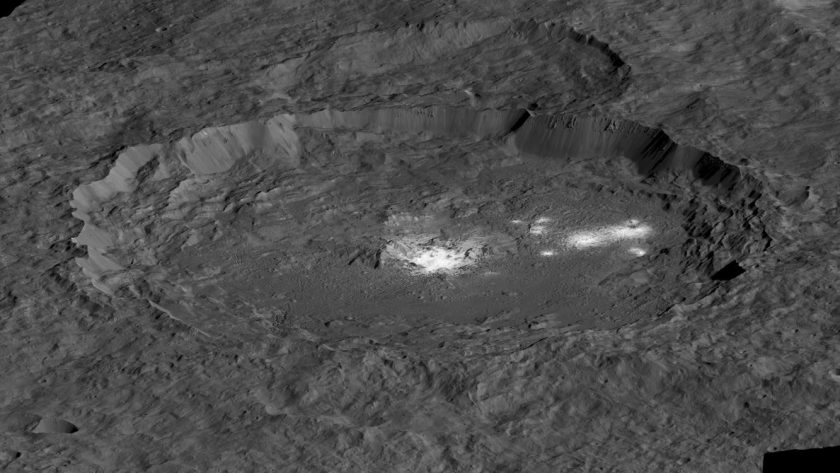Explaining Salt on Ceres
November 11, 2019

Forged billions of years ago from rock and ice, the dwarf planet Ceres was thought to have no active geology. But pictures sent back from the NASA Dawn space probe changed that view when they showed bright, white spots of salt on the surface of
the alien world.
The spots turned out to be remnants of cryomagma, salty water exuded by cryovolcanoes that tap into underground reservoirs and that could play a key role in mixing the ingredients for life on other worlds, such as Jupiter’s moon Europa. And in the case of the spots at the bottom of Ceres’ Occator Crater, they were much younger than the crater itself, only 4 million years old compared with 20 million years. Research led by the UT Jackson School of Geosciences in partnership with NASA’s Jet Propulsion Laboratory (JPL) delved into the factors that influenced the volcanic activity and formed the distinctive spots — and proposed an explanation for the age gap between the cryomagma and the crater.
Learning more about how these volcanoes work on Ceres could help scientists get a handle on the primary forces that drive their activity, said lead author Marc Hesse, an associate professor in the Department of Geological Sciences at the Jackson School.
“Cryovolcanism looks to be a really important system as we look for life,” he said. “So, we’re trying to understand these ice shells and how they behave.”
The research was published Feb. 8, 2019, in the journal Geophysical Research Letters. The research was co-authored by Julie Castillo-Rogez, a planetary scientist at NASA’s JPL. At 585 miles across, Ceres is the largest planetary body in the asteroid belt between Mars and Jupiter. The presence of the bright spots suggests that heat and energy generated by asteroid impacts could jumpstart geology on Ceres, creating reservoirs of cryomagma that were then brought to the surface by conduits such as fractures.
However, earlier research conducted by other scientists found that the conditions on Ceres would not allow for the cryomagma generated by the Occator Crater impact to flow for more than about 400,000 years.
The age discrepancy between the 4 million-year-old salt deposits and the 20 million-year-old impact didn’t make sense. But Hesse and Castillo-Rogez were able to significantly extend the life of the cryomagma by including more up-to-date details on Ceres’ crustal chemistry and physics.
Back to the Newsletter